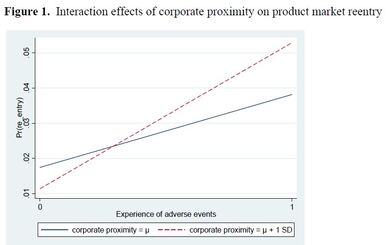 We all try to learn from our failures, and we believe that we usually do so successfully. Similarly, we often think that firms can learn from failures, and this belief is shared by people who observe (and work in) firms and those who study organizational learning. It may be shocking to realize that some of the details on whether and how firms learn are not well documented. For example, we know that firms will change something after experiencing failure, but we are rarely able to measure whether they change the right thing and whether the change is an improvement. This is why research by Cheon Mok (John)Kim, Colleen M Cunningham, and John Joseph published in Academy of Management Journal is interesting. They checked whether medical device firms could distinguish between failures caused by product features or market conditions and found that they could. So far so good. They also checked whether failures due to product features led to re-entry with a new product, and this is where things got more complicated – and interesting. The answer is yes, but not always. More importantly, the researchers could distinguish the conditions that made such learning more likely. If the business unit that withdrew a failed product was close to the corporate headquarters – geographically, in the organizational hierarchy, or in product lineup – then it was more likely to re-enter with a new product. What is so distinctive about being close to the corporate center? One feature is attention and surveillance; another is support and resources. These seem like heads and tails of a coin, and clearly either one could have this effect, and most likely they act in concert. In fact, the findings were even stronger for the more repairable types of failures. If the failure was distinctly from the product design, not the user, then corporate proximity had greater effect. If the product failure was severe, then corporate proximity had greater effect. In both cases, the fault is more obvious and more easily traced to the firm, and accordingly it should be easier to learn from failure. And learn they did. This is important knowledge for two reasons. First, although we often assume that learning from failure happens, it is often the case that the very things we assume to be true are faulty in some way, and need to be checked carefully. That is also true about learning from failure, because the conditions that make it happen are not always present. The firm with highly decentralized management that is also geographically dispersed and diversified has three strikes against learning from failure. There are many such firms. This brings us to the second point. From what we know about learning, we should also be able to design organizations that learn well. Given how learning is related to connections within the firm, and the attention (and surveillance, support, and resources) that follows, designing firms with structures that fail to learn is a completely unnecessary error, especially given the costs of simply giving up when re-entry with an improved product would have been possible. If we know how firms learn, we can design them to learn well. Kim, Cheon Mok (John), Colleen M Cunningham,and John Joseph. 2022. Corporate Proximity and Product Market Reentry: The Role of Corporate Headquarters in Business Unit Response to Product Failure. Academyof Management Journal, forthcoming. Comments are closed.
|
Blog's objectiveThis blog is devoted to discussions of how events in the news illustrate organizational research and can be explained by organizational theory. It is only updated when I have time to spare. Archives
May 2024
Categories |
 RSS Feed
RSS Feed